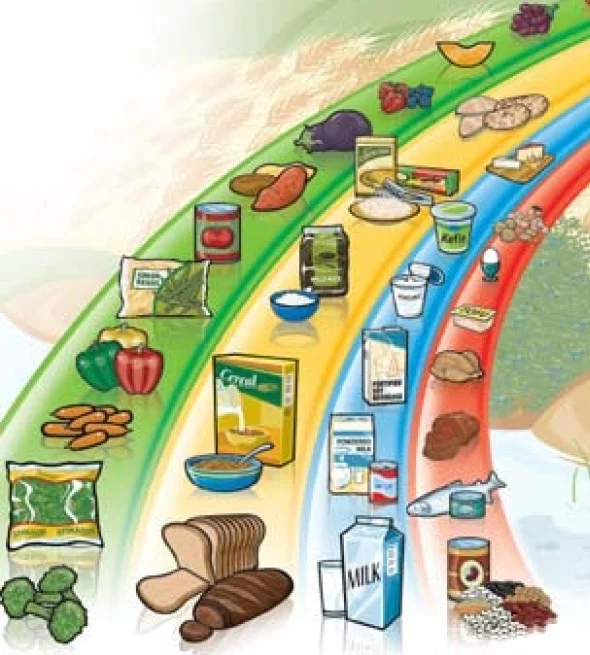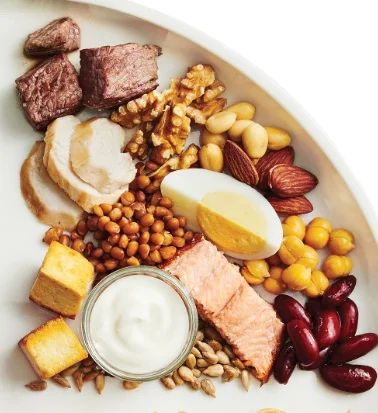Canada’s New Food Guide: What Educators Need To Know Part 1
Canada’s Food Guide is meant to guide our eating patterns and food choices. It also acts as an important tool to help students learn about eating well, as it is a key component in the Ontario Health and Physical Education Curriculum. What do the recent changes to the Food Guide mean for you as an educator? Here is some Food Guide “food for thought” as you teach the healthy eating expectations in your classroom.
A plate image replaces the previous food groups rainbow
In this updated Food Guide, the rainbow visual of the food groups has been swapped out for a plate visual with key messages that emphasize eating protein foods, having plenty of vegetables and fruits, choosing whole grain foods and making water your drink of choice.
A protein “food group”
Former Milk and Alternatives and Meat and Alternatives food groups
The protein section of the Food Guide plate combines the former Milk and Alternatives and Meat and Alternatives food groups into a group framed around protein foods. The other two plate sections (grains; vegetables and fruits) are easily understood by students as “food groups” because they are focused on whole foods that are categorized based, in part, on how they grow and where they come from. Protein, however is a macronutrient, not a “food”, and macronutrients are an abstract and more challenging concept to learn - especially for young children - that is not introduced in the curriculum until Grade 4.
Tip: Avoid getting into the concept of protein with your students until at least the junior grades. In primary grades or younger, focus instead on learning about the foods that are in the protein group - eggs; meats (including wild game) and poultry; nuts and seeds; fish and shellfish; dairy products; beans, peas and lentils; and soy products. Students can explore where these (and all) foods come from and how they are grown - which helps to build children’s overall food literacy.
Where did all the serving sizes go?
You’ll notice that serving sizes and number of servings of foods per day for different life stages are absent. Instead, the new Food Guide plate focuses on proportions of types of foods. Specifically, the plate visual shows:
A ½ plate of vegetables and fruits
A ¼ plate of protein
A ¼ plate of whole grains
”Serving sizes”, however, are commonly referred to in the current Ontario healthy eating expectations, starting in grade four. Later this year we will receive further information about how to move forward with regard to serving sizes and the revised Food Guide. In the spring, Health Canada will be releasing Canada’s Healthy Eating Pattern for health professionals and policy makers which will “provide more specific guidance on amounts and types of foods, as well as life stage guidance” (1).
Tip: In the meantime, if you do teach grades four and up, for those expectations that focus on serving sizes and amounts, you can continue to use the 2007 version of the Food Guide. You could also re-focus away from servings sizes and instead have students reflect on what a potential plate or bowl (lunch or dinner) looks like in their family and the types of foods they enjoy from the three groupings seen on the plate.
The “variety” message is alive and well!
Health Canada recommends that we should “Eat a variety of healthy foods each day”. The variety message is an important foundational concept - due to the fact that every day our bodies need 52 different nutrients for optimal growth and health. However, the idea that specific foods are “healthy” (and that others are “unhealthy”) can be ambiguous and may inadvertently lead to children feeling judged or shamed for their food choices and policing of meals and snacks in schools and classrooms - all of which can lead to a negative relationship with food. A more constructive approach is to focus on overall patterns of eating (2).
Tip: You can emphasize the importance of “variety” by supporting students in enjoying eating, exploring new foods, and choosing nutrient-rich foods (and “other” foods in moderation) that they like. This will help them to have a positive relationship with food and eating and to get the nutrients and energy they need to grow, learn, and do all the things they like to do.
What’s Next?
Use the tips provided above in your teaching of the healthy eating expectations.
Take a big picture and positive approach that supports student nutrition while we await further details from the Food Guide. This includes:
Encouraging students to respect and nourish their bodies, and be attuned to their hunger and satiety cues.
Using activities that help students understand where food comes from and build food skills.
Send us your questions! We want to hear from all of you - what are your questions about the revised Canada’s Food Guide? We’d love to help you address them.
June 24, 2019 update: Check out these translated versions of the Food Guide Snapshot! Use the version(s) that reflect the language(s) spoken in your school community.
Look for an update from us on further educator-specific considerations, and new tools and ideas to help you teach healthy eating in the classroom.
References:
Government of Canada. (2019). Revision process for Canada’s food guide: New tools and resources. Retrieved from https://www.canada.ca/en/health-canada/services/canada-food-guide/about/revision-process.html#a5.
Freeland-Graves J.H., Nitzke S. Academy of Nutrition and Dietetics. Position of the academy of nutrition and dietetics: Total diet approach to healthy eating. J. Acad. Nutr. Diet. 2013;113:307–317. doi: 10.1016/j.jand.2012.12.013. [PubMed]





